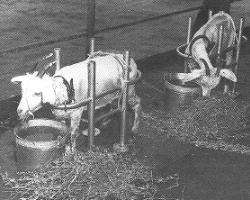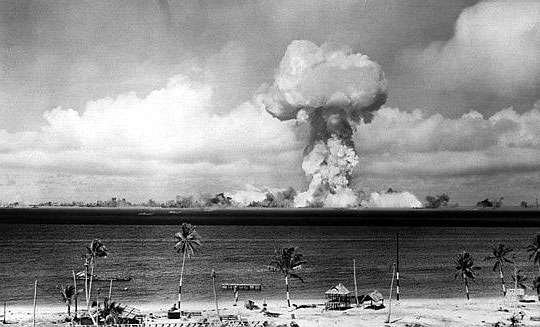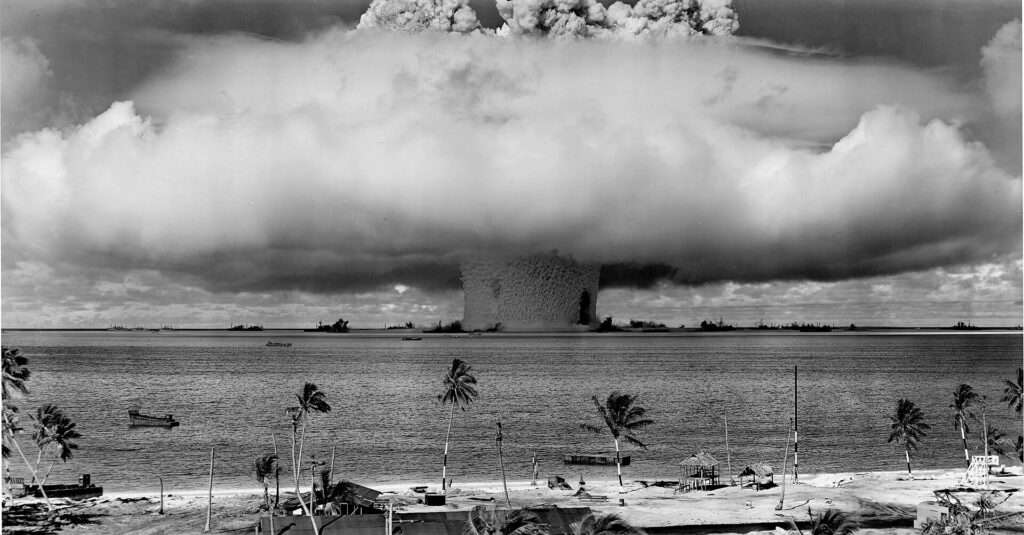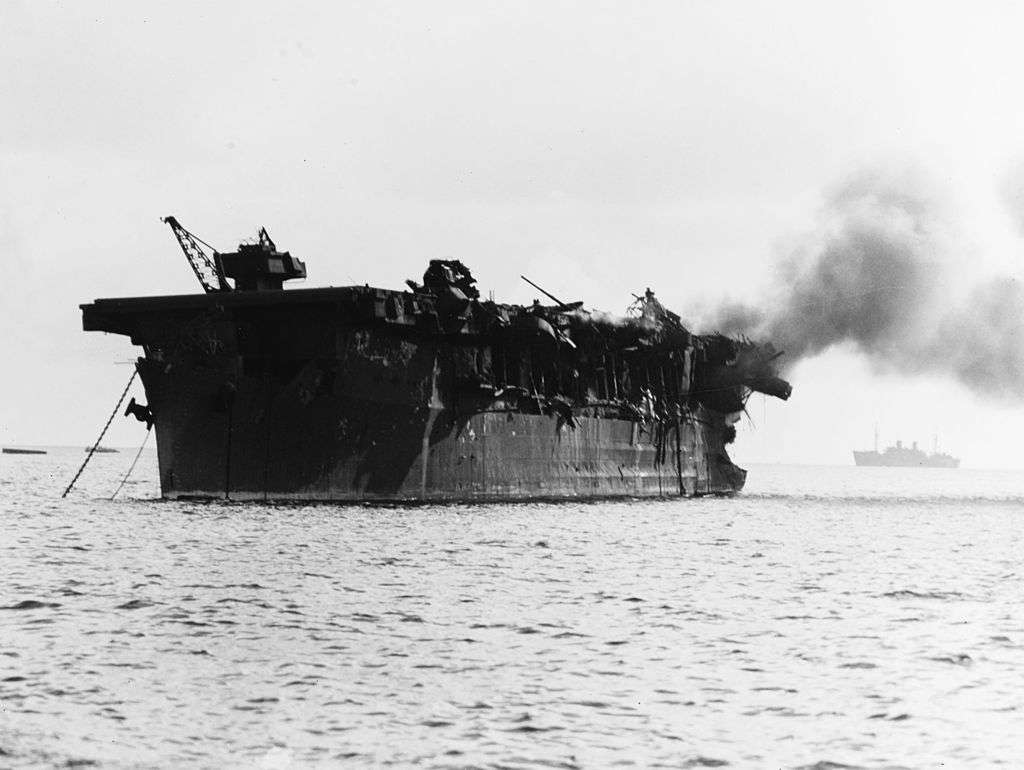Operation Crossroads was a pair of nuclear weapon tests conducted by the United States at Bikini Atoll in mid-1946.
The purpose was to investigate the effect of nuclear weapons on naval warships.
In the wake of World War II, after witnessing the cataclysmic effect of the atomic bombs on Hiroshima and Nagasaki, the global community was forced to reconcile with the reality of nuclear warfare.
For the first time, mankind possessed the power to annihilate entire cities with a single weapon, changing the complexion of warfare forever.
Yet, alongside the fears, these new weapons generated a sense of intrigue and exploration in military and scientific communities worldwide.
How could this power be harnessed, and what were the full extents of its potential, both as a weapon and possibly as an energy source?
For the United States, as the only nation with atomic capabilities at that time, the period following WWII was one of both introspection and exploration. There was an evident need to understand the implications of nuclear weaponry more thoroughly.
 Hiroshima after the bombing in August 1945.
Hiroshima after the bombing in August 1945.
The bombings of Hiroshima and Nagasaki had indeed shown the devastating power of atomic bombs, but those were air bursts over cities, designed for maximum destructive effect.
How would a nuclear weapon affect naval fleets, a significant part of any major military power’s arsenal?
Naval warfare had been a crucial component of WWII. From the attack on Pearl Harbor to the battles in the Atlantic and Pacific Oceans, naval power played a key role in determining the war’s outcome.
Given this context, the U.S. felt compelled to understand what would happen if nuclear weapons were used against a naval fleet.
Operation Crossroads was born from this necessity, seeking to assess the impact of nuclear blasts on naval ships and, by extension, naval warfare.
Simultaneously, the U.S. was wrestling with the reality of entering the Atomic Age on a diplomatic and political front.
Control over nuclear weaponry, questions about sharing atomic technology with allies, considerations on its use in future conflicts, and the rising tensions with the Soviet Union were all significant issues that the U.S. government had to face.
Operation Crossroads, thus, was conceived amid this myriad of challenges and questions, standing not just as a military operation but also as a statement of intent in the emerging geopolitical landscape.
Planning Operation Crossroads
Organizing an operation of this magnitude was no small task. The scale of Operation Crossroads, both in terms of its logistical demands and the sheer number of personnel involved, was unparalleled.
Planning started in January 1946, under the command of Vice Admiral William H. P. Blandy, who worked in tandem with a team of military experts, scientists, and government officials.
The location for the tests, Bikini Atoll, was selected for its remoteness and suitability to host the experiment.
At that time, the Atoll was inhabited by around 167 natives, who were relocated to another island by the U.S. government to conduct the tests.
Once the location was secured, the U.S. assembled a fleet of over 90 vessels. These included both obsolete and captured enemy ships, which were dispersed around the lagoon to assess the impact of the nuclear explosions.
The ships were loaded with various types of military equipment and supplies, as well as animals, to mimic the potential human effect.
 Goats on the deck of a test ship before the ‘Able’ test.
Goats on the deck of a test ship before the ‘Able’ test.
It was the first public nuclear tests, and the event was heavily covered by the press. A large press corps was present, and the US government had even issued a series of press releases about the tests.
The operation was planned in three parts – tests Able, Baker, and Charlie. However, Charlie was eventually abandoned due to the unexpected amount of nuclear contamination from the Baker test.
Execution of Operation Crossroads
Test Able, conducted on July 1, 1946, involved a Mk III plutonium bomb named “Gilda,” which was dropped from a B-29 bomber, similar to the one used on Nagasaki.
It was aimed to explode at an altitude of 520 feet, with the aim of causing maximum damage to the assembled ships below.
 The explosion from the ‘Able’ test.
The explosion from the ‘Able’ test.
However, due to a navigational error, it missed its target by about 710 yards, and the resulting damage was less extensive than expected.
The Baker test, on July 25, 1946, differed from Able in that it was an underwater detonation.
A similar bomb to the one used in Able, named “Helen of Bikini,” was suspended 90 feet underwater.
 The resulting mushroom cloud from the ‘Baker’ test.
The resulting mushroom cloud from the ‘Baker’ test.
The resulting detonation created a massive spray dome and a radioactive mist known as the “base surge”.
This test exceeded the expectations of many observers in terms of both the initial blast effect and the extent of radioactive contamination, rendering a significant portion of the target fleet unsalvageable and causing the cancellation of the Charlie test.
 This close-up of the explosion during the ‘Baker’ test, you can see USS Saratoga being lifted from the water.
This close-up of the explosion during the ‘Baker’ test, you can see USS Saratoga being lifted from the water.
The complexity of planning and executing Operation Crossroads was a testament to the scientific, military, and logistical prowess of the United States in the post-war era.
These tests showcased not only the destructive power of nuclear weapons but also provided crucial data to strategize future warfare and defense systems.
Impact And Legacy
Operation Crossroads, as one of the earliest series of nuclear tests conducted by the United States post World War II, left an indelible mark on various facets of society — from geopolitics to science, and from the environment to humanitarian concerns.
In the geopolitical landscape, Operation Crossroads sent a clear message about U.S.’ nuclear capabilities, contributing to escalating tensions during the nascent stages of the Cold War.
 USS Independence burning after one of the tests.
USS Independence burning after one of the tests.
The fact that these tests were widely publicized and were carefully observed by international parties, particularly the Soviet Union, indicated the emergence of nuclear weapons as key elements in maintaining strategic military balance.
The visible demonstration of nuclear power in these tests could arguably be seen as the first significant step into the atomic diplomacy era that underpinned Cold War politics.
From a scientific perspective, Operation Crossroads provided invaluable data about the devastating power and implications of nuclear weapons.
The Baker test, particularly, with its significant radioactive fallout, offered a potent demonstration of nuclear contamination in addition to explosive force.
This test significantly informed subsequent research on nuclear fallout and influenced later nuclear test designs.
 Navy fireboat washes down the USS New York to reduce the radioactive contamination.
Navy fireboat washes down the USS New York to reduce the radioactive contamination.
Additionally, the tests also accelerated advancements in radiation detection and safety measures, given the significant contamination issues that arose in their aftermath.
However, the impacts of Operation Crossroads were not just limited to military and scientific fields.
The environmental toll was severe — the tests caused long-term damage to the local ecosystem, impacting both marine and terrestrial life.
Bikini Atoll became a symbol of nuclear contamination, and even decades later, the effects of the radiation are evident in the area.
The human cost of the operation was also high. The indigenous people of Bikini Atoll, who were relocated to facilitate the tests, faced hardships in their new locations due to lack of resources and the unfamiliar environment.
The inability to return to their ancestral lands due to radioactive contamination, even years after the tests, has remained a long-standing issue, leading to serious ethical questions about nuclear testing on inhabited lands.
In the larger historical context, the legacy of Operation Crossroads is a stark reminder of the human capacity for destruction, even as we strive for scientific and technological advancement.
The lessons learned from these tests continue to influence discussions about nuclear disarmament and non-proliferation, emphasizing the importance of employing scientific prowess for the benefit of humanity, rather than its detriment.





